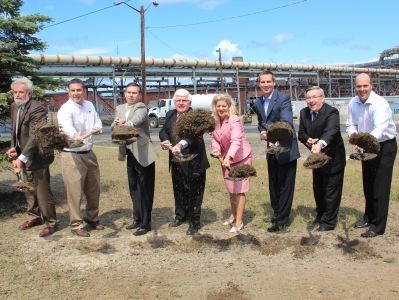A spokesperson for Vale says there will be “fewer jobs” at the Copper Cliff Smelter as the company moves toward a single-furnace operation around 2016, but said she's not sure exactly how many positions will be affected.
“Given the lead time, we're going to do our best to minimize the impacts to our people through retirements, attrition and reassignment to other areas of the operation,” Angie Robson said.
A team of company smelter and human resources officials has been formed to study the various aspects of this change, and over the next year this team has been tasked with putting together revised plans for a single-furnace operation.
Steelworkers Local 6500 president Rick Bertrand, who represents workers at the smelter, said he's not sure how many of the roughly 700 people who work at the smelter will lose their jobs through the move.
He said he's glad the company is planning to make the reductions through attrition, and he's asked to work with the company to reduce the impact on his members.
Bertrand said the company's announcement came as a surprise to him.
“We've been running with two furnaces for years and years,” Bertrand said. “We've never reduced down to one furnace in the past, even when the market was low.”
As Vale phases out one of its two furnaces in Copper Cliff, the company's $2-billion atmospheric emissions reduction project, known as Clean AER, will also be cut in half.
Robson said the company made the “strategic decision” partly because the company's Long Harbour processing facility will be coming online over the next few years.
Construction at Long Harbour is expected to be completed in February 2013.
Currently, material coming out of Vale's Voisey's Bay mine is processed in Copper Cliff, but will instead be processed in Long Harbour once the facility is ready to be used, she said.
Total refined nickel production will not change, according to an email statement from Vale.
With the “current market conditions,” which include a nickel price that's currently hovering at around $7.90 a pound, Vale has been forced to reinvent its business model for its base metal operations around the globe, Robson said.
“Vale globally has moved from what was before a very aggressive growth strategy to a focus on really generating value rather than production volume,” she said.

Vale globally has moved from what was before a very aggressive growth strategy to a focus on really generating value rather than production volume.
Angie Robson,
Vale spokesperson
While the company is reducing its smelter capacity in Copper Cliff, it's also accelerating the Victor Capre mine project, which had been previously been put on hold, Robson said.
She said she's unsure of the exact timelines for the projects, referring to Totten Mine as well.
“It will be our next new mine in Sudbury after Totten Mine,” Robson said.
“Certainly it's something that holds a lot of promise for us.”
In terms of Clean AER, Robson said Vale still hopes to complete the project by the end of 2016, although it will be significantly scaled back. The company now plans to spend $1 billion on Clean AER, as opposed to the original $2 billion.
Clean AER is able to go forward on a smaller scale because there will be significantly less emissions coming out of the smelter, Robson said.
Once Clean AER is completed, sulphur dioxide emissions will be about 50-per-cent less than originally projected, she said. The company will still be meeting Ministry of Environment regulations, Robson said.
She said work on Clean AER is continuing, although the project now needs to be redesigned.
“The first converter is delivered, and it's currently being installed,” Robson said.
Whether the smelter is operating with one or two furnaces, the nickel particulate capture element of the Clean AER project will go ahead because it is not affected by dropping one furnace.
“That work is continuing.”
However, because the smelter is now going to be a one-furnace operation, engineers now have to re-scope some of the work, such as the gas capture mechanisms, Robson said.
“With the one furnace, we'll no longer require a second acid plant, which was originally contemplated in the first Clean AER plan,” she said.
When the Clean AER project was announced last year, with much fanfare, officials emphasized the large economic impact it was going to have on the city's economy.
But Robson said even the downsized Clean AER will have a “very significant” economic impact.
“It's still a billion-dollar project,” she said.
Vale will be discussing the situation with local mining supply and service companies who had hoped to win Clean AER contracts, Robson said.
“Some of them will not be affected at all,” she said.
“Some will be affected. As we do the further study in terms of our plans in the course of this year, we'll be able to have those conversations with our local supply and service sector.
“But there's still a lot of work that will be available for them.”
